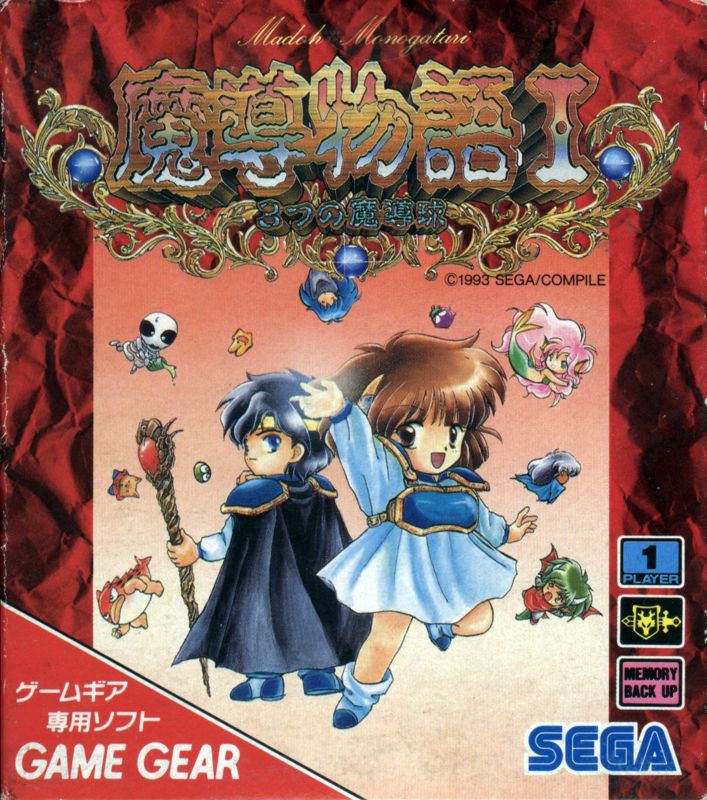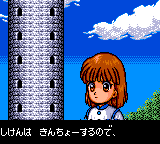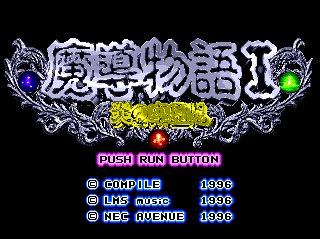Retro Replay Review
Gameplay
Madō Monogatari I places you in the robes of Arle Nadja, a young apprentice sorceress who must prove her mettle in the infamous Tower of Satan. The core loop revolves around exploration, puzzle-solving, and strategic combat, creating a rhythm that keeps players engaged as they delve deeper into the dungeon’s winding corridors. Movement and interaction are handled from a first-person perspective, allowing for an immersive dungeon-crawling experience that feels both classic and fresh.
(HEY YOU!! We hope you enjoy! We try not to run ads. So basically, this is a very expensive hobby running this site. Please consider joining us for updates, forums, and more. Network w/ us to make some cash or friends while retro gaming, and you can win some free retro games for posting. Okay, carry on 👍)
Combat transitions seamlessly to a side-scrolling view, blending turn-based decision making with real-time pressure. Enemies continue their assault even if you hesitate, which adds a layer of urgency to each spell choice. You’ll learn to chain button holds with directional inputs to unleash a diverse array of elemental and support magic. Mastering these inputs is rewarding, as casting a powerful “Fireball” or “Sleep” spell at the right moment can turn the tide of battle.
The game’s difficulty curve is well balanced: early encounters introduce you to the timing and practice needed for complex spells, while later floors of the Tower demand careful resource management. Healing items are limited, and Arle’s mana pool depletes quickly if spells are spammed without thought. This encourages exploration for hidden treasures and backtracking to earlier floors when you uncover new scrolls or potions.
Graphics
For its era, Madō Monogatari I delivers surprisingly vibrant visuals. The 3D dungeon environments employ simple textures but use light and shadow effectively to cultivate a foreboding atmosphere. Each floor of the Tower of Satan features distinct color palettes—from mossy stone walls to fiery chambers—that help you navigate and remember key areas.
Character sprites in side-scrolling battles have a charming, anime-inspired style that foreshadows the art direction of the later Puyo Puyo series. Enemies range from mischievous ghosts to oversized golems, each animated with clear telegraphs for their attacks. The fluidity of these battle animations—combined with screen-shaking effects when spells land—creates an engaging spectacle, even if the resolution feels dated by modern standards.
Menus and spell icons are crisp and intuitive, using color-coding to indicate elemental affinities and status effects. The HUD remains unobtrusive, displaying Arle’s health, mana, and key items in a compact bar at the screen’s edge. Overall, while the game doesn’t push polygon counts, its cohesive art style and thoughtful presentation still make for a visually coherent adventure.
Story
The narrative premise of Madō Monogatari I is delightfully straightforward: Arle must conquer the Tower of Satan to pass her sorcery exams. While not overly complex, the story is enriched by playful character interactions and humorous enemy dialogue. Familiar faces from the Puyo Puyo universe pop up as both friend and foe, offering nods to long-time fans while remaining accessible to newcomers.
Between floors, brief vignettes show Arle’s interactions with her magic school peers and teachers, grounding the high-stakes dungeon crawl with lighthearted school life moments. These scenes build her personality—curious, determined, and compassionate—making her progression from novice to adept feel earned. There’s also a gentle undercurrent of mystery: why was this ominous tower built, and what lies at its summit?
Rather than unfolding a grand epic, the story excels in small-scale charm. Each successful exam stage feels like a milestone, and uncovering hidden journals or secret rooms adds layers to Arle’s world. Though concise, the narrative offers enough motivation to keep you invested until the final showdown at the tower’s pinnacle.
Overall Experience
Madō Monogatari I is a refreshing blend of old-school dungeon crawling and inventive combat mechanics. The fusion of turn-based strategy with real-time pressure sets it apart from many contemporaries, rewarding quick thinking and precise inputs. This hybrid system can feel challenging at first, but it ultimately provides a dynamic combat experience that’s both strategic and adrenaline-filled.
Exploration is equally engaging: puzzles range from simple switch mechanics to hidden floor traps that require careful observation. Finding that elusive key or deciphering a cryptic hint from a dungeon inscription brings genuine satisfaction. The game’s pacing encourages you to pause and examine your surroundings, turning every corner of the Tower of Satan into a potential discovery.
While dated in some graphical and audio aspects, Madō Monogatari I’s core design shines through. It offers a compelling challenge for RPG enthusiasts, especially those who appreciate character-driven magic systems and inventive level design. Whether you’re a fan of early ’90s role-playing innovations or simply looking for a unique sorcery-themed adventure, Arle’s quest up the Tower of Satan remains a memorable journey worth undertaking.
 Retro Replay Retro Replay gaming reviews, news, emulation, geek stuff and more!
Retro Replay Retro Replay gaming reviews, news, emulation, geek stuff and more!









Reviews
There are no reviews yet.